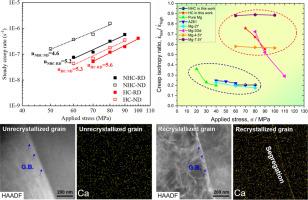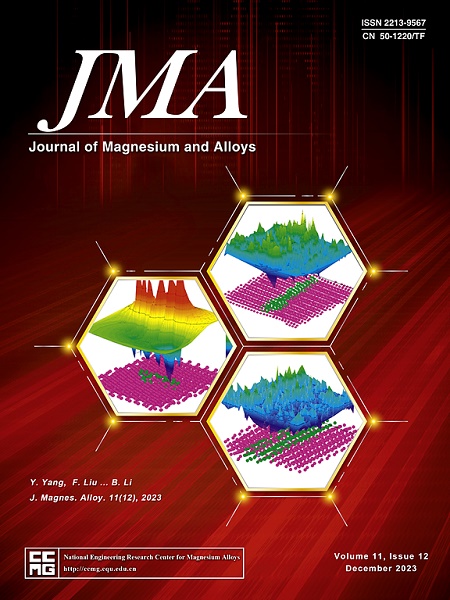Tensile creep anisotropy and its weakening mechanism in a dilute Mg-Ca alloy
IF 15.8
1区 材料科学
Q1 METALLURGY & METALLURGICAL ENGINEERING
引用次数: 0
Abstract
The tensile creep anisotropy of a dilute-alloyed Mg-0.3wt%Ca sheet is investigated along the rolling direction (RD) and normal direction (ND). Strong creep anisotropy is shown between the RD and ND, owing to the easy twinning and the Ca-segregation along twin boundaries during creep loading along the ND. To weaken the creep anisotropy, hot-compression parallel to the RD-ND plane is performed and the continuous dynamic recrystallization mechanism induces a bimodal microstructure with the coexistence of unrecrystallized and recrystallized grains. The creep anisotropy is successfully weakened after hot-compression, and the creep resistance is also significantly enhanced along both loading directions. With the assistance of microstructural characterization, the weakened creep anisotropy is ascribed to the dislocation arrays in the interiors of recrystallized grains and the Ca-segregation along the boundaries of recrystallized grains. Compared to commercial Mg alloys with poor creep property and rare-earth alloyed Mg with high price, good creep performance and low production cost can be synchronously realized in the hot-compressed Mg-0.3wt%Ca alloy. Thus, this work proposes a new perspective for producing creep-resistant Mg alloys.

稀镁钙合金的拉伸蠕变各向异性及其削弱机制
研究了稀合金 Mg-0.3wt%Ca 板沿轧制方向(RD)和法线方向(ND)的拉伸蠕变各向异性。由于在沿 ND 方向的蠕变加载过程中容易发生孪生和孪生边界上的钙偏析,因此在 RD 和 ND 之间显示出很强的蠕变各向异性。为了减弱蠕变各向异性,进行了平行于 RD-ND 平面的热压,连续的动态再结晶机制诱导出未再结晶和再结晶晶粒共存的双模微观结构。热压后,蠕变各向异性被成功削弱,沿两个加载方向的抗蠕变性也显著增强。在微结构表征的帮助下,蠕变各向异性的削弱归因于再结晶晶粒内部的位错阵列和再结晶晶粒边界上的钙偏析。与蠕变性能较差的商用镁合金和价格昂贵的稀土合金镁相比,热压 Mg-0.3wt%Ca 合金可同步实现良好的蠕变性能和较低的生产成本。因此,这项工作为生产抗蠕变镁合金提出了一个新的视角。
本文章由计算机程序翻译,如有差异,请以英文原文为准。
求助全文
约1分钟内获得全文
求助全文
来源期刊

Journal of Magnesium and Alloys
Engineering-Mechanics of Materials
CiteScore
20.20
自引率
14.80%
发文量
52
审稿时长
59 days
期刊介绍:
The Journal of Magnesium and Alloys serves as a global platform for both theoretical and experimental studies in magnesium science and engineering. It welcomes submissions investigating various scientific and engineering factors impacting the metallurgy, processing, microstructure, properties, and applications of magnesium and alloys. The journal covers all aspects of magnesium and alloy research, including raw materials, alloy casting, extrusion and deformation, corrosion and surface treatment, joining and machining, simulation and modeling, microstructure evolution and mechanical properties, new alloy development, magnesium-based composites, bio-materials and energy materials, applications, and recycling.
 求助内容:
求助内容: 应助结果提醒方式:
应助结果提醒方式:


